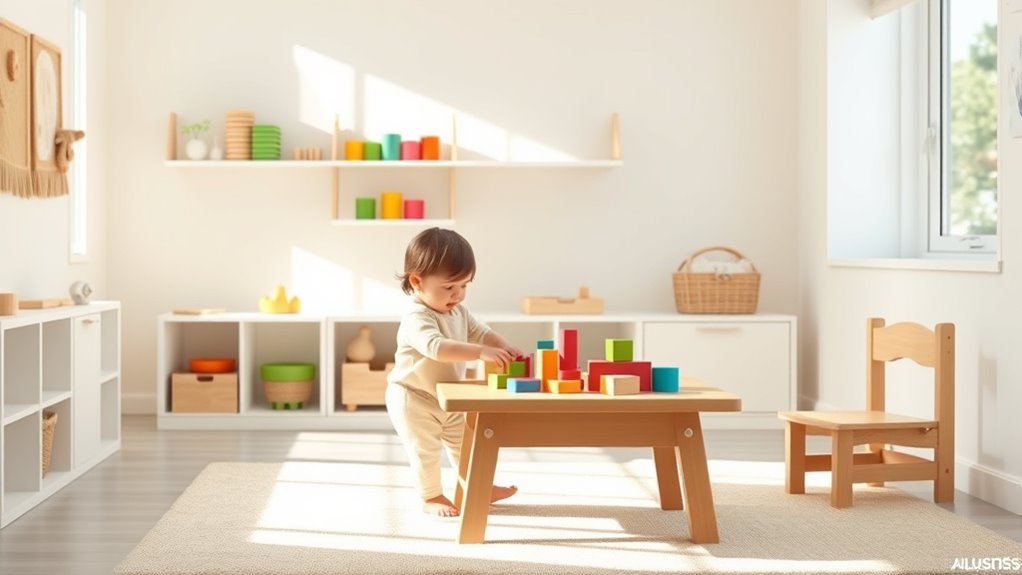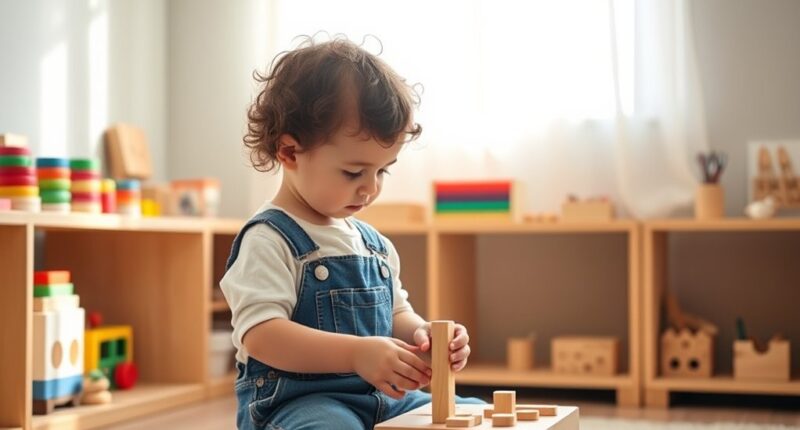To boost your toddler’s independence at home using Montessori methods, create a prepared environment with accessible materials, such as low shelves and open containers, that invite exploration. Incorporate sensory activities like textured fabrics and sensory bins, along with practical life exercises like pouring and dressing. Focus on fostering decision-making and confidence through simple, engaging tasks. As you build these routines, you’ll see your child become more confident and self-reliant—keep exploring for even more ideas to support their growth.
Key Takeaways
- Create a prepared environment with accessible, organized materials to foster self-directed learning and decision-making.
- Incorporate practical life activities like pouring, buttoning, and sweeping to build skills and confidence.
- Use developmentally appropriate tools and activities to promote safe, independent exploration.
- Engage toddlers with sensory activities that stimulate curiosity and refine fine motor skills.
- Observe interests and gradually introduce more complex tasks to support skill development and independence.

Have you ever wondered how to bring the benefits of the Montessori method into your home? The good news is, you can create a nurturing environment that promotes independence and confidence for your toddler right in your living space. One of the core aspects of Montessori is engaging children through sensory activities, which help them explore and understand the world around them using all their senses. Incorporate everyday objects like textured fabrics, smooth stones, or scented herbs into your child’s play area. These activities aren’t just fun—they foster concentration, refine motor skills, and encourage curiosity. You can set up simple sensory bins filled with rice, beans, or pasta, allowing your child to dig, pour, and sift. These activities give your little one the chance to learn through touch and experimentation, building a foundation for problem-solving and cognitive development. Additionally, choosing appropriate learning tools designed for their developmental stage can enhance their engagement and safety during these activities.
Create a Montessori-inspired space with sensory activities that foster curiosity, independence, and motor skill development.
Practical life exercises are another essential part of Montessori at home. They teach children valuable skills while promoting independence and self-esteem. Think about everyday tasks your child can safely participate in, such as pouring water from one container to another, spooning dried beans, or folding napkins. These activities might seem simple, but they help your toddler develop fine motor skills, concentration, and a sense of order. Set up designated areas where your child can easily access the tools they need for these tasks, like small pitchers, child-sized utensils, or cloths. This way, they learn to take responsibility for their actions and gain confidence in their abilities.
Creating a prepared environment is key. Keep materials within your child’s reach, so they can choose activities independently. Use low shelves and open containers to encourage self-directed learning. This setup not only fosters independence but also helps your child develop decision-making skills. As they master basic skills, gradually introduce more complex practical life activities, like buttoning, zipping, or sweeping, to challenge and expand their capabilities.
Incorporating sensory activities and practical life exercises into your daily routine makes learning natural and enjoyable for your toddler. It’s about giving them opportunities to explore, manipulate, and practice skills at their own pace. When you observe their interests and provide appropriate tools and environments, you’re supporting their innate desire to learn and grow. The Montessori approach isn’t about structured lessons; it’s about creating a space that respects your child’s developmental needs and encourages independence at every step. By doing so, you’re helping your toddler build a strong foundation for lifelong learning and confidence.
Frequently Asked Questions
How Do I Start Montessori Activities With My Toddler?
To start Montessori activities with your toddler, first choose appropriate materials that match their developmental stage, like simple puzzles or sorting toys. Set up a dedicated learning environment by organizing materials on low shelves within their reach. Encourage independence by guiding them to select activities and explore at their own pace. Keep the space calm and inviting, fostering curiosity and confidence as they learn through hands-on experiences.
What Safety Precautions Are Necessary for Montessori Materials?
You’ve got to play it safe when handling Montessori materials. Start with thorough childproofing measures, ensuring sharp edges are covered and choking hazards are removed. Always sanitize materials regularly to keep things clean and germ-free. Keep a close eye during activities, and choose age-appropriate items. Safety’s no accident—by taking these precautions, you create a secure environment where your toddler can explore and learn confidently.
How Can I Adapt Montessori Principles for Limited Space?
To adapt Montessori principles for limited space, you can incorporate smart storage solutions like wall-mounted shelves and multi-purpose furniture modifications to maximize your area. Keep materials accessible and organized, encouraging your toddler’s independence. Use compact, child-sized furniture and rotate activities to prevent clutter. These adjustments help create a functional, inviting environment where your child can explore and learn, even in a small space.
When Should I Introduce New Montessori Tasks to My Child?
Think of introducing new tasks as a game of chess—timing is everything. When your child hits key developmental milestones, like improved coordination or language skills, it’s the right time to add new Montessori activities. Stay tuned to their interests and abilities, and be involved to guide them. Patience and observation are your best tools, helping you know exactly when to challenge or support them for ideal growth.
How Do I Handle Resistance or Lack of Interest From My Toddler?
When your toddler shows resistance or lack of interest, try using motivational strategies like offering choices or incorporating their favorite activities to spark curiosity. Be patient and avoid forcing them, as patience-building is key. Keep activities short, playful, and positive, gradually encouraging exploration. Celebrate small successes to boost confidence, and remember that consistent, gentle encouragement helps your child develop independence naturally over time.
Conclusion
By incorporating the Montessori method at home, you’re planting seeds of independence in your toddler. Just like a gardener carefully tends to each plant, you nurture their confidence step by step. Remember, one small activity—like tidying up toys—can blossom into a lifelong skill. With patience and consistency, you’ll watch your child grow into a self-reliant, curious explorer, ready to take on the world one confident step at a time.









